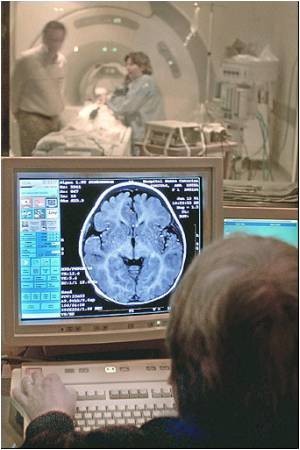A gene-splicing machine can be turned into a switch that controls the expression of hundreds of human genes using a rare, small RNA.

These genes encode proteins that play essential roles in cell physiology such as several transcription regulators, ion channels, signaling proteins, and DNA damage-repair proteins. Their levels in cells are regulated by the activity of the splicing machinery, which acts as a valve to control essential regulators of cell growth and response to external stimuli.
Dreyfuss, who studies RNA-binding proteins and their role in such diseases as spinal muscular atrophy and other motor neuron degenerative diseases, describes the findings as "completely unanticipated."
Complicated SplicingAs DNA is transcribed into RNA and then into the various proteins that perform the functions of life, non-coding gene sequences (introns) need to be removed from the transcribed RNA strand and the remaining gene sequences (exons) joined together. This is the job of specialized molecular machinery called the spliceosome. There are two varieties of spliceosomes, the so-called major and minor. The major spliceosome is by far the most abundant, such that the role of its minor counterpart is often disregarded.
"Most of the time the minor spliceosome, which has similar but not identical components to that of the major, isn't even mentioned," says Dreyfuss. With each type of spliceosome recognizing different splicing cues, the major spliceosome acts on the vast majority of introns (>200,000) and the minor one splices the several hundred minor-type introns.
But the evolutionary persistence and role of the minor spliceosome has been a puzzle to scientists, since the minor introns it targets are far outnumbered by the major introns handled by the major spliceosome, and the minor spliceosome is often inefficient. But the mRNAs produced from genes that have a minor intron are not ready until all their introns, both major and minor, are spliced. Thus a single inefficiently spliced minor intron can hold up expression – mRNA and protein production – for an entire gene. Researchers have therefore wondered why the apparently superfluous minor spliceosome hasn't been eliminated altogether through normal evolution.
More to the MinorDreyfuss's team discovered that there's more to the minor spliceosome while investigating the effects of different physiological conditions such as cell stress, transcription, and protein synthesis on small noncoding RNAs. "We inhibited transcription and then measured what happens to the amount of each of the small noncoding RNAs three or four hours later," he explains. "That's when we noticed that U6atac levels plunged." They found that U6atac, which is also the catalytic component of the minor spliceosome, is extremely unstable in a cell. "If you stop the transcription of U6atac, you stop producing it, and very quickly its levels become terribly low. And we knew that it's already one of the rarest snRNAs in cells. So we thought this surely will have an effect on minor intron splicing."
Next, says Dreyfuss, "we started looking for any conditions where the levels of U6atac might be increased, so that the less efficient genes will be able to express. Out of the various conditions that we surveyed, we found that cell stress, which activates the p38MAPK pathway, causes a very large and rapid increase in U6atac and with that, a huge enhancement of the splicing of those minor introns that otherwise splice very inefficiently." (p38MAPK is a key component of cell signaling pathways that are activated during cell stress such as the release of inflammatory cytokines, ultraviolet radiation, heat, and osmotic shocks, so p38MAPK play an important role in cellular growth and differentiation, apoptosis, cancer, and autophagy).
A Valve and a SplicerSure enough, when U6atac levels are rapidly and steeply increased, "the bottleneck to the production of mRNA from those few hundred genes that contain a minor intron is removed." The p38MAPK signaling pathway – when activated under cell stress -- is one of potentially many ways in which U6atac levels can be modulated.
When minor spliceosome activity is reduced, the minor introns are retained in the mRNA while the major introns are spliced out. This signals the mRNA for degradation, limiting the expression of genes that contain minor introns.
The findings point to an entirely new and vital role for the minor spliceosome and particularly its U6atac component. More than simply splicing out minor introns, U6atac actually functions as a control and regulatory mechanism for minor intron-containing genes. "We propose that the minor spliceosome was conserved because it's used as a valve, not simply a spliceosome," Dreyfuss says. "It's a very important switch and it's an unexpected kind of mechanism."
Dreyfuss sees parallels between the discovery of U6atac's role in splicing and previous work by his lab that revealed the importance of U1, a major spliceosome component, in preventing the premature termination of mRNA transcription. "That was completely unanticipated and is a major area of interest, because this is a major way of regulating the transcriptome and mRNA length."
One of the team's next steps will be to determine exactly how p38MAPK, and possibly other molecules, acts to control U6atac levels.
Meanwhile, they have demonstrated the "folly" of casually disregarding the seemingly unimportant. "This provides a new perspective on minor introns and minor spliceosomes, because it's been a real mystery," says Dreyfuss.
Source-Eurekalert
 MEDINDIA
MEDINDIA




 Email
Email




